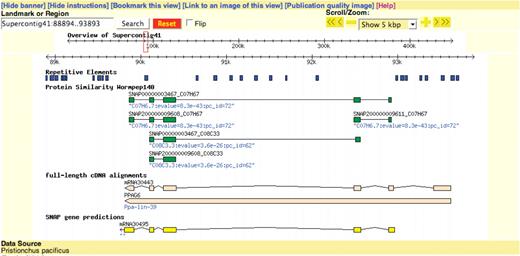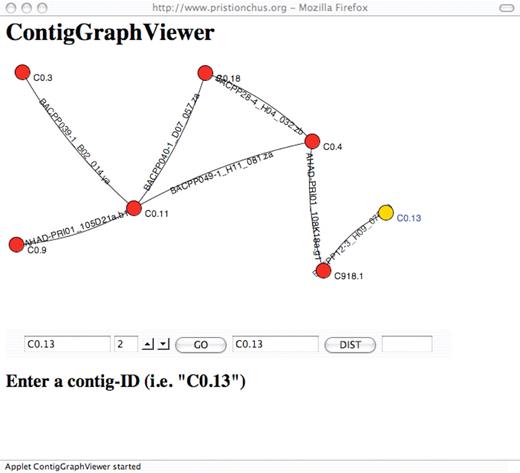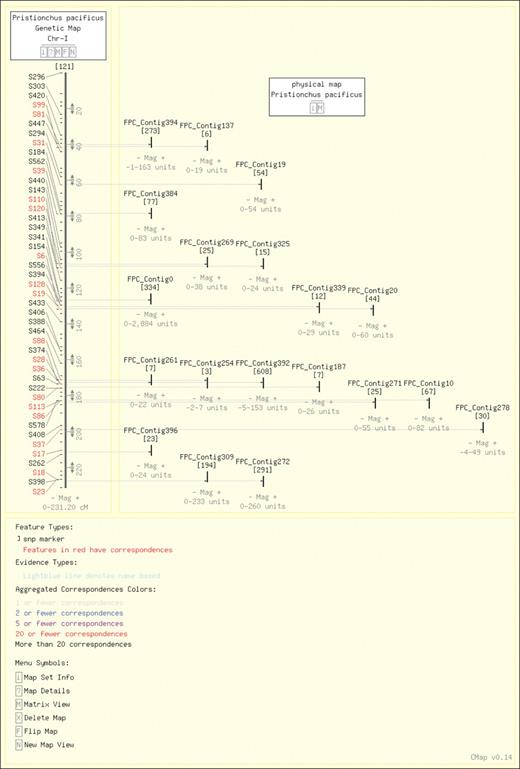-
PDF
- Split View
-
Views
-
Cite
Cite
Christoph Dieterich, Waltraud Roeseler, Patrick Sobetzko, Ralf J. Sommer, Pristionchus.org: a genome-centric database of the nematode satellite species Pristionchus pacificus, Nucleic Acids Research, Volume 35, Issue suppl_1, 1 January 2007, Pages D498–D502, https://doi.org/10.1093/nar/gkl804
Close - Share Icon Share
Abstract
Comparative studies have been of invaluable importance to the understanding of evolutionary biology. The evolution of developmental programs can be studied in nematodes at a single cell resolution given their fixed cell lineage. We have established Pristionchus pacificus as a major satellite organism for evolutionary developmental biology relative to Caenorhabditis elegans, the model nematode. Online genomic information to support studies in this satellite system can be accessed at Author Webpage. Our web resource offers diverse content covering genome browsing, genetic and physical maps, similarity searches, a community platform and assembly details. Content will be continuously improved as we annotate the P.pacificus genome, and will be an indispensable resource for P.pacificus genomics.
INTRODUCTION
The nematode Pristionchus pacificus was established as a comparative counterpart to the reference nematode Caenorhabditis elegans. Direct comparisons in development down to the single cell level are feasible as both nematodes follow distinct fixed programs of cell divisions and cell deaths (1). Similar to C.elegans, P.pacificus is an ideal system for forward genetics given its hermaphroditic mode of reproduction and other advantages, such as short generation time, high brood size and the availability of genetic tools. Our satellite system P.pacificus has and continues to deliver exciting examples of differences to C.elegans in organ development, behavior and ecology [for review, see Ref. (2)].
P.pacificus is a member of the Diplogastridae family, a monophyletic group that possibly includes more than 300 species (3). Some diplogastrids show unique morphological features such as mouth form dimorphisms in adult hermaphrodites. The phylogenetic lineages of P.pacificus and C.elegans have probably diverged 200–300 million years ago (4). Given their long phylogenetic separation, most conservation signal has vanished on the nucleotide level and protein similarities are at an average level of ∼60% identity. Preliminary gene order analysis suggests that there is only limited conserved microsynteny between chromosomes of C.elegans and P.pacificus (5). Comparisons of both species may therefore yield valuable insights into the evolution of function relative to divergence in sequence and gene order.
The genomics era was heralded for P.pacificus with the announcement of an NHGRI-funded genome sequencing initiative (Author Webpage). The project will be finished in late 2006 and is complemented by a toolkit encompassing a high-density genetic linkage map and physical map (6,7). All aforementioned genomics resources were bundled and made available online on Author Webpage, our web portal for P.pacificus genomics. Genetic and physical map services were moved from the discontinued AppaDB (8) to Author Webpage.
Web portal
The online resource has a consistent layout for each page (Figure 1). A navigation bar can be found at the top of each page, a news section to the left and the actual content fills the remaining part of the screen. The navigation bar represents the division of the website into six sections: The Genome—providing access to genome assemblies and annotation, BLAST—similarity searches against various Pristionchus databases, Maps—featuring a versatile map viewer of the genetic and physical map, Sequence retrieval—download functions, WikiOnchus—a community portal, and People—a directory of researchers active in the field. Sections are either self-explanatory or provide help pages to the web user.

Overview of web portal division. The Navigation bar is placed to the top of the web page. There is a news board to the left and the main content below the navigation bar. The welcome page is shown, which features an introductory text as to the concepts of comparative evolutionary studies.
Genome
We put a preliminary draft assembly plus annotations (repetitive elements, gene predictions, protein similarities) together, which will be subject to future changes. Web users have access to these preliminary data via the Generic Genome Browser framework (9), an open-source genome viewing software. Many nematologists are familiar with the Generic Genome Browser framework as it is a key component of Wormbase (10). At the time of writing, the P.pacificus genome extends over ∼4000 supercontigs. Alignments of expressed sequence tags and predicted coding sequences are placed onto these supercontigs. Repetitive elements based on the RECON algorithm (11) and local protein-level similarities to other species are also integrated. Figure 2 shows an example of Supercontig 41 containing the homeotic gene Ppa-lin-39 and corresponding annotations.

Graphical display of Pristionchus genome annotation. We employ the highly customizable Generic Genome Browser framework for viewing, analyzing and exporting local sequence annotation.
Similarity searches
BLAST searches are a long-standing standard to extract biologically meaningful sequence similarities. This section of the website offers extensive search capabilities of the genomic sequence from P.pacificus and related species, such as Pristionchus maupasi and Pristionchus entomophagus. The Mapping tool provides details on the position of contigs within supercontigs. Furthermore, BAC and Fosmid end mapping onto the genome may be accessed from here as well. Alternatively, one could consult the ContigGraphViewer, a JAVA applet, for a graphical representation of BAC and Fosmid end mappings (Figure 3).

ContigGraphViewer—a JAVA applet for graphically representing long-distance relations in the Pristionchus genome assembly. BAC and Fosmid end mappings onto contigs are shown as a graph where vertices constitute contigs and arcs carry BAC or Fosmid labels.
Genetic and physical map
A major contribution to the success of our model system is the availability of a high-density genetic map (6). A physical map build from AFLP fingerprints of BAC ends complements this map (7). Both maps are interconnected as many polymorphic markers were generated in BAC end sequences.
The CMap framework (12) provides immediate access to both maps. CMap is a generic open-source map viewer, which offers a multitude of functions to view, compare and download map data. Both maps are manually curated and constantly updated once new markers become available. Figure 4 shows a comparative view of genetic and physical map for Chromosome I.

Comparative map view—genetic map of Chromosome I is shown in conjunction with all contigs of the physical map that have a corresponding SSCP marker.
Sequence retrieval
To facilitate local analyses beyond the functionality offered by this web site, complementary sequence data can be retrieved from this section. This part of the web site will undergo many update cycles as more genome sequence and annotation accumulates.
WikiOnchus
WikiOnchus constitutes a Pristionchus community forum, which is based on the MediaWiki system (Author Webpage). WikiOnchus contents are open to all web users. However, editing of pages is restricted to a group of trusted friends of Pristionchus. If you are new to nematodes in general and Pristionchus in particular, you may find our selection of introductory texts very helpful (Author Webpage). Other texts get experimentalists introduced to material and methods of P.pacificus. There is also an inventory of Pristionchus strains under Author Webpage. If you want to contribute to the growing knowledge base, please contact the first author of this paper.
Pristionchus people
Watch how the community is growing and where former lab members set up their own research. An almost complete directory of the Pristionchus community gives an idea on active research areas.
CONCLUSION
Our presented web portal is a unifying resource of Pristionchus genomics bringing together genome databases, analyses and visualizations thereof. P.pacificus is a well-established satellite organism to Caenorhabditis species and offers significant amenities such as the comprehensive tools and resources that were outlined in this article. We are certain that pristionchus.org will meet all requirements with regard to Pristionchus genomics of researchers in nematology and beyond.
Funding to pay the Open Access publication charges for this article was provided by the Max Planck Society.
Conflict of interest statement. None declared.
REFERENCES
Author notes
*Correspondence may also be addressed to Ralf J. Sommer. Tel: +49 7071 601 371; Fax: +49 7071 601 498; Email: [email protected]




Comments